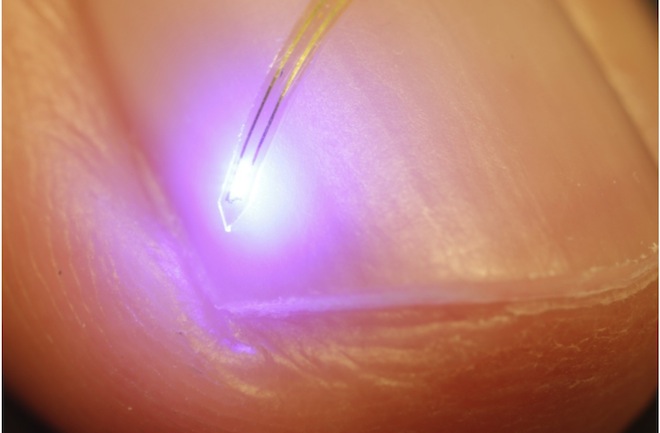
Making electronic implants for the body is hard to do: tissue is delicate and stiff components can irritate it. Then there’s getting those implants into the relevant organ without invasive surgery.
To help solve these problems, John A. Rogers, a materials science professor at the University of Illinois, and Michael Bruchas, an anesthesiologist at Washington University in St. Louis, built an electronic LED device so tiny it can be injected into delicate tissue, such as in the brain, without harming it. The experiment appears in this week’s issue of the journal Science.
Rogers told Discovery News that brain tissue is not only fragile, it also tends to move around because brains are suspended in fluid, and that creates problems when one tries to put relatively stiff, rigid electronics or fiber optics in place.
To get around this the researchers put together an extremely small circuit board with light-emitting diodes on it. The whole device is only about 25 microns thick. For comparison, a human hair is about 100 microns and fiber-optic cable strands are about 125. The thinness is part of what makes it so flexible.
The substrate – the “board” that the electronics sit on, is made of polymer, while silk helps it bond with the tissue. Silk is compatible with tissue and is even used in dissolving stitches. Rogers has made use of silk’s properties before, when he made electronics that can dissolve inside the body.
They then injected the device into the brain of a mouse that was genetically engineered to have brain cells that responded to flashes of light from the LEDs. That way Rogers and his collaborators could tell which cells were being stimulated and confirm that the device worked. That kind of smallness would come in handy when studying individual neurons.
One of the big advantages to injecting a device like this into the brain, Rogers said, is that it doesn’t require a wire connected to a computer protruding from the skull. With mice and rats, such apparatus tends to restrict their movement and alter their behavior. This new kind of electronics allows scientists to monitor specific parts of the brain during basic research.
Being so small, the LEDs did not irritate the surrounding tissue as much as traditional electrodes. Electrodes are used inside the brain for a variety of disorders, such as Parkinson’s. But there’s often swelling of the brain tissue after they are taken out. Very tiny electronic components avoid those problems.
To be clear, the mouse still had a small wire coming out of its head, but that was to connect to a power source worn in a kind of small hat. In the future it might be possible to power the devices wirelessly. Rogers said the big challenge is making the antennas that would pick up the power from an external source small enough.
The LED technology isn’t likely to be used or human therapies, Rogers said. But the research isn’t just for literally lighting up brain cells – it demonstrates that electronics can be made small enough to go into organs that are usually pretty delicate. That goes beyond brains – hearts, lungs and kidneys could also be implanted with electronics this way.
Oh my goodness! Incredible article dude! Thank you, However I am having difficulties with your RSS. I don’t know the reason why I am unable to subscribe to it. Is there anybody else having the same RSS problems? Anyone who knows the answer will you kindly respond? Thanks!!
LikeLike
Thanks my friend, the RSS feed ,its on the left pane of the blog, just enter your Email ID and click follow.
LikeLike
I’d should verify with you here. Which is not something I usually do! I enjoy studying a post that can make folks think. Additionally, thanks for permitting me to remark!
LikeLike
I have been checking out some of your posts and i must say pretty good stuff. I will definitely bookmark your website.
LikeLike
I like this weblog very much so much good info.
LikeLike
You have remarked very interesting details! ps decent internet site.
LikeLike
I was highly pleased to acquire this web-site.I wanted to thanks for your time for this amazing read!! I surely enjoying each and every little bit of it and I have you bookmarked to take a look at new stuff you blog post.
LikeLike
I just want to say I’m newbie to blogs and certainly liked you’re blog. More than likely I’m likely to bookmark your website . You surely have remarkable article content. Regards for revealing your web page.
LikeLike